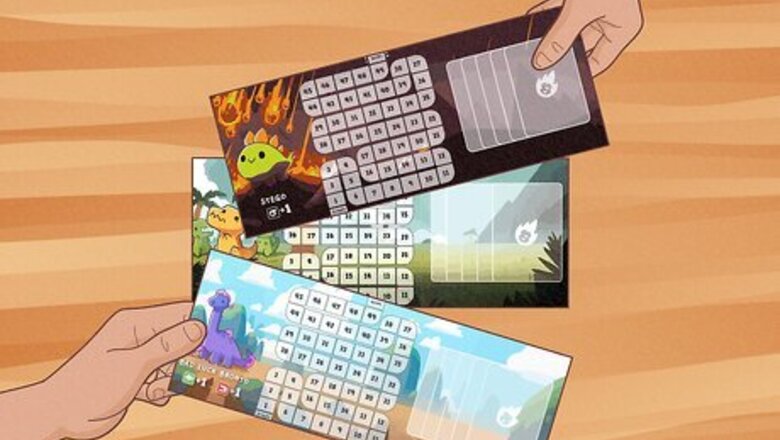
views
Setting Up the Game
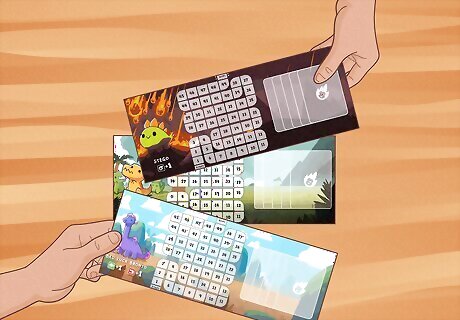
Take turns picking a dinosaur board for each player. Gather 2-4 players total. Decide who chooses first. For this game, the youngest often goes first, but you might also play a Rock Paper Scissors tourney, or decide that the person with the earliest birthday in the year goes first. Then, each player chooses their dinosaur by selecting a player board with that dinosaur on it. Each dinosaur plays slightly differently according to the traits displayed on the board. We’ll get to that in a moment. Take the dino token of your color and place it on the first spot on your board.
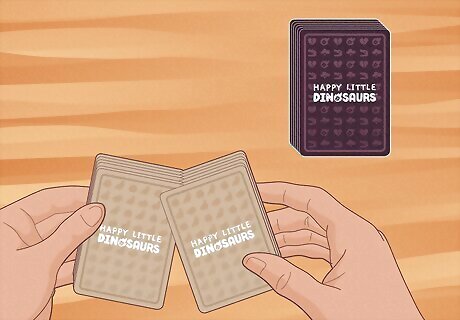
Separate the light and dark cards, and shuffle them separately. Happy Little Dinosaurs features 2 main card types: light and dark. These are also known as the Main Deck and Disaster Deck, respectively. Shuffle both decks and place them face down in the center of the table, where every player can reach them.
Basic Gameplay
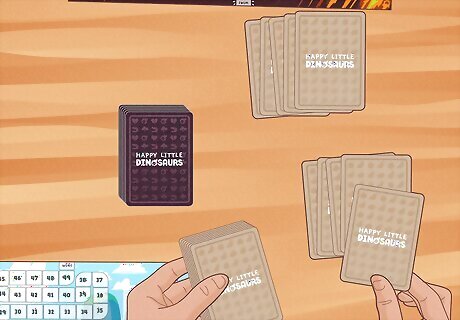
Deal 5 cards from the main deck to each player. Each player takes 5 cards from the face-down light deck. This is their hand. For this first round, deal 5 cards to each player. In future rounds, players will draw from the main deck until they have 5 cards before the round starts, keeping unused cards from the previous round in their hand. Keep your hand secret! If you want to survive, you’ll have to be sneaky and clever about what cards you have.
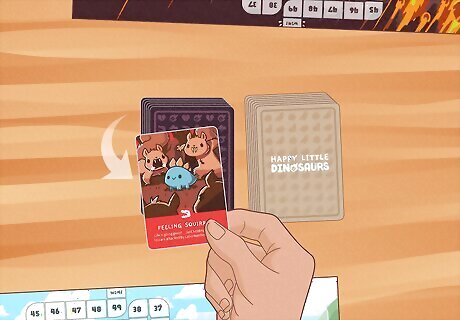
Reveal the top disaster card from the disaster deck. Once everyone has their hand of 5 light cards, turn over the top disaster card from the disaster deck. Place it next to the deck, where everyone can see it. Disaster cards are penalties for the player who loses the round, so revealing them now lets everyone know what’s at stake if you lose this hand, as well as strategize as to which card they’ll play. Disaster cards come in 4 color-coded varieties: Natural Disasters (Green), Predatory Disasters (Red), Emotional Disasters (Blue), and Meteors (Black).
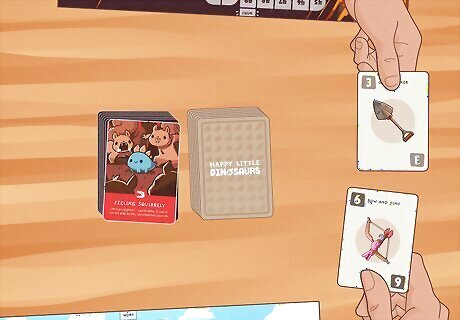
Play a point card from your hand at the same time as everyone else. There are no turns in Happy Little Dinosaurs. Everyone plays at the same time! Choose a point card from your hand to play. Then, count down from 3: “3, 2, 1, Go!” On “go,” everyone flips over their chosen card, revealing it to the other players. Point cards are light cards with numbers in their corners. Generally, the best strategy is to try to play the card with the highest number, but not always! Some point cards have bonus effects that activate when you play them. We’ll talk about those effects in the next section. Players shouldn’t play Instant Cards at this point. Instant cards have no numbers in their corners, and can only be played when the card says it can be played. If a player has no point cards to play, they discard their hand and draw 5 more cards, repeating until they have at least 1 point card.
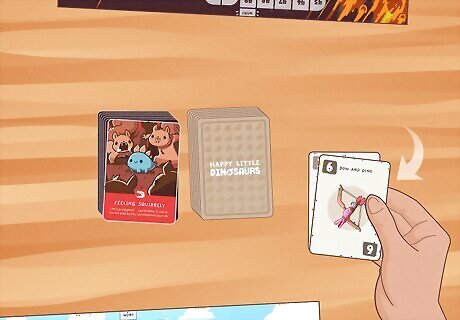
Collect all the played point cards if you played the most points. In general, the name of the game is to play the highest point card. If, when everyone reveals their point cards, you have the highest card, you collect all the played point cards for that round. You’ve won the round, but you haven’t quite won the game just yet!
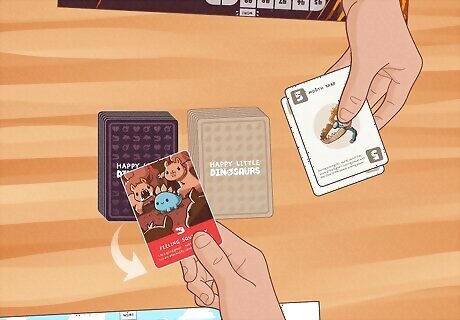
Collect the face-up disaster card if you played the least points. If you played the lowest point card, you collect the disaster card and place it on the disaster area of your board, where everyone can see it. You’ve lost the round, but all is not lost! In fact, collecting a disaster card isn’t always a bad thing, as you’ll see in the next step. Disaster cards stay on your board the entire game, and don’t go away (unless a card has a special effect that allows for it). If you collect the disaster card, you may also choose to discard any light card in your hand.
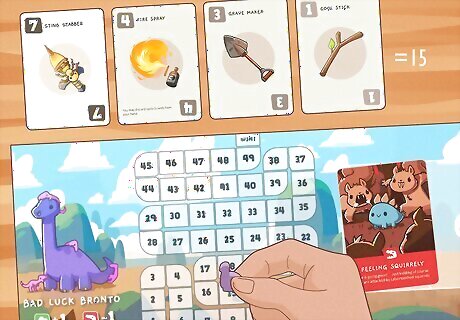
Move your dino forward according to your points and disaster cards. The player who played the highest point card and collected other players’ point cards adds up the points on each card played that round. Then, they move their dinosaur forward that number of spaces. In addition, every player moves their dino forward the same number of spaces as the number of disaster cards they have on their board. For example, if you won the round with a point card of 7, you’d take the other players' cards and add them to your 7 (e.g. 7+4+3+1=15), then move that number of spaces on your dino board. Then, every player checks how many disaster cards are on their board and also moves that number of spaces. If you have 3 disaster cards, for example, you’ll automatically move 3 spaces every round.
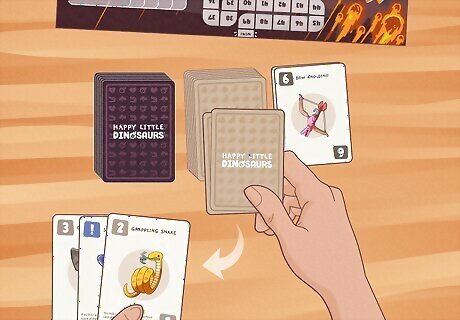
Start a new round by drawing cards until you have 5. Once everyone has played their hands, counted their points, and moved their dinos forward on their boards, a new round begins. Discard all the played point cards into a face-up pile. Then, each player with fewer than 5 cards draws more until they have 5 cards. Finally, the round begins again, and players choose point cards to play.
Winning the Game
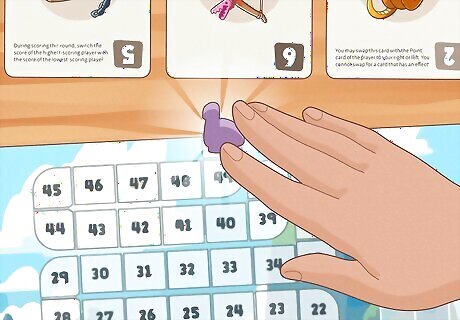
Win the game by escaping or by being the last dino standing after multiple rounds. The first player to score enough points (50) to get them through their escape route and onto the last space on their personal dino board wins the game! To get there, keep drawing cards, playing hands, and advancing your dino token. Or, if every other player is eliminated by disasters, then the last player standing automatically wins, even if they haven’t made it to the end of their board.
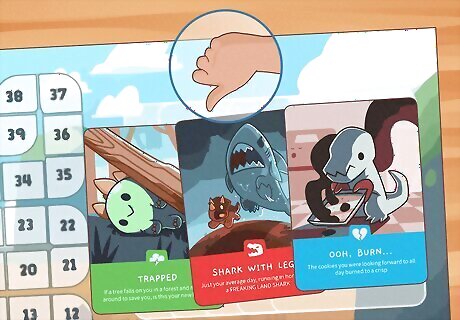
Lose the game if you collect 3 disaster cards of the same color, or of each color. While disaster cards can move you further up, they can also spell certain doom for your dino. If you collect 3 disaster cards of the same color, you’re immediately eliminated from the game and must sit out for the rest of it. Same goes for if you collect 1 disaster card of each color. Meteor cards (black) count as disaster wildcards. In other words, they count as a disaster of every color. So if you collect 2 red disasters plus a meteor, you’re out! You’re also eliminated if you collect 2 other disasters of any color while you have a meteor card in your disaster pile. That means that 1 red card plus 1 blue card plus 1 meteor will still eliminate you.
Special Cards, Dinosaur Traits, & Tiebreakers
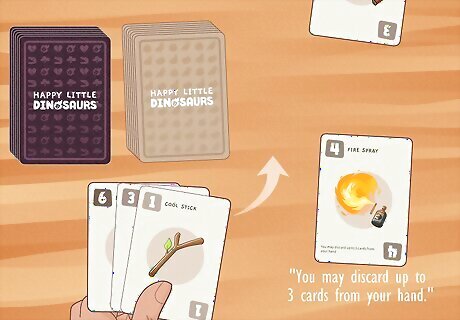
Point card effects Many point cards have bonus effects written on the bottom of the card. These effects do many things, like letting you discard cards, draw more cards, steal other players’ cards, and more. These effects activate as soon as the card is turned over, so choose wisely! For example, when you play Fire Spray (4), you may discard up to 3 cards from your hand. Point cards are resolved starting with the lowest card value. If 2 of the same cards are played, the player further away from escape resolves their card first. However, some cards specify that they’re to be played “During scoring of this round…” These cards’ effects always happen first.
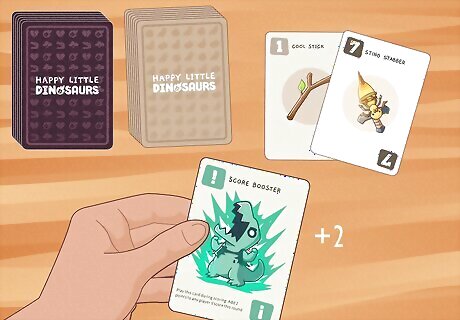
Instant cards Instant cards are cards from the main deck that don’t have point values. Instead, they have useful effects that can turn the tide of the game. You play them whenever the card says you can play them, and their effects are instant. For example, the Score Booster card says, “Play this card during scoring. Add 2 points to any player’s score this round.” So, even after you’ve played a point card, you can play this card in addition to it in order to give yourself (or someone else) 2 extra points this round.
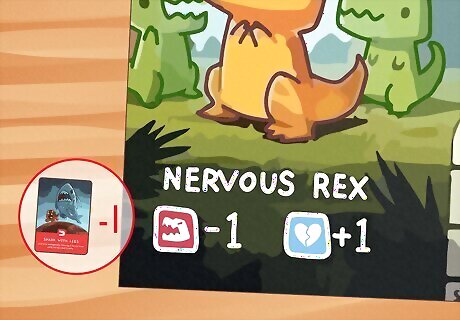
Dinosaur traits Each dino comes with traits, and you can find these under your dino’s portrait on your dino board. These traits show a certain disaster type next to a point type. This means that whenever that type of disaster appears, you automatically add or subtract points from your played point card’s value that round. For example, Nervous Rex has Red -1 and Blue +1, so if that round features a red disaster, whatever point card they play will automatically be worth 1 less point. On the other hand, if that round features a blue disaster, Rex’s point card is automatically worth +1 point. Remember to count these points when you move your dino, too!
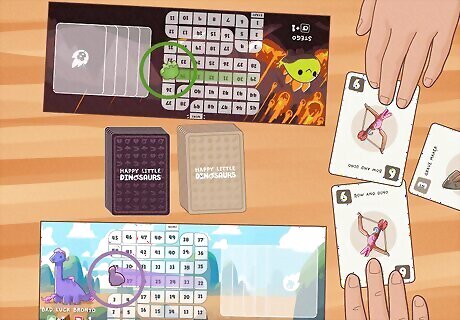
Ties Sometimes, multiple players will end up with the same amount of points in a round, even after they’ve applied instant cards and dino traits. In this case, every player who tied for the most points gets to move their dino that many spaces. If multiple players tie for last, though, they enter Sudden Death and each play another point card at the same time, repeating until the tie is broken. The player who plays the lowest-value point card loses and takes the disaster card. If a player in sudden death doesn’t have a point card to play, they take the disaster card. If multiple players run out of point cards to play, the disaster card is moved to the bottom of the disaster deck and nobody has to worry about it… for now. If all players tie, move the disaster card to the bottom of the deck and end the round. Nobody scores point cards. Some cards invert the round’s points, swapping two player’s positions in the round ranking. If one of these cards is played during a tied round, all points of tied players are inverted. This inversion doesn’t apply to sudden death, though—you’re still trying to play the highest card.
Playing a 2-Player Game
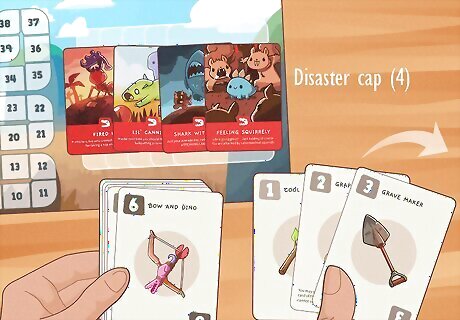
Remove cards with 1-3 points, and increase the disaster cap to 4. The game is more or less the same with only 2 players, but with a couple of tweaks. First, remove all the point cards that have values 1-3 from the main deck. Then, make it so that players need to gather 4 of the same color disaster card, or 2 of each of the 3 types, in order to be eliminated. This makes the game smoother.
Strategy
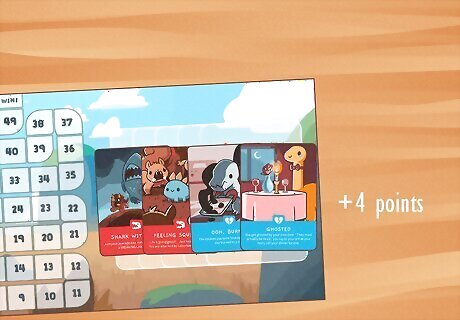
Use disasters to get lots of passive points. Disasters are double-edged swords. They put you at risk of losing, but they also give you points every single round you have them, and those points can add up! Bold, risky players can try to purposefully get disaster cards for passive points, while using effect cards that do things like protect you from further disasters to defend yourself. Remember that the only way to lose is by getting 3 of the same color, or 1 of each different color of disaster. So if you have 2 blues and 2 reds, you’ll be getting 4 guaranteed points each round. Of course, you’re also at a huge risk of going extinct…
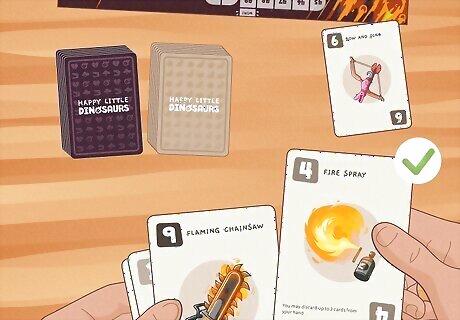
Prioritize card effects over card values. If you’ve got a high card that’ll probably win you the round, go ahead and play it. But if you’ve got a point card with a powerful effect, like one that lets you discard a bunch of cards you don’t want, play the card with the useful effect, instead. It’s a balancing act of winning rounds with high cards and using low cards to help set you up to win later rounds.










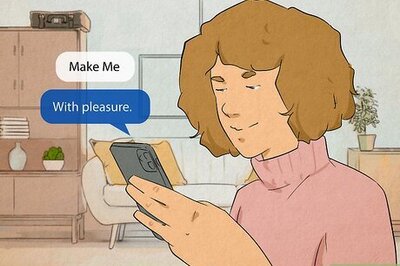



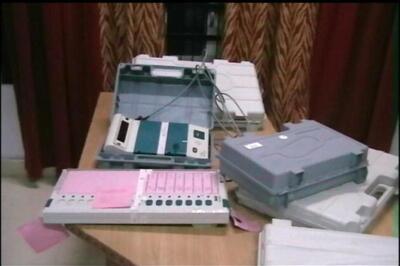
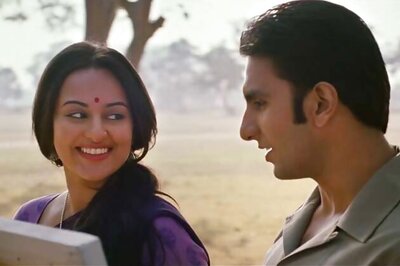
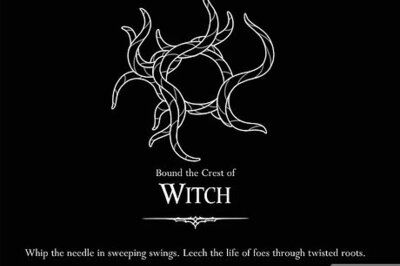



Comments
0 comment